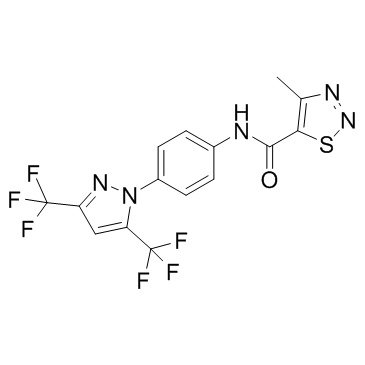223499-30-7
| Name | N-[4-[3,5-bis(trifluoromethyl)pyrazol-1-yl]phenyl]-4-methylthiadiazole-5-carboxamide |
|---|---|
| Synonyms |
N-{4-[3,5-Bis(trifluoromethyl)-1H-pyrazol-1-yl]phenyl}-4-methyl-1,2,3-thiadiazole-5-carboxamide
CRAC Channel Inhibitor,BTP2 btp2 1,2,3-Thiadiazole-5-carboxamide, N-[4-[3,5-bis(trifluoromethyl)-1H-pyrazol-1-yl]phenyl]-4-methyl- YM-58483 |
| Description | YM-58483 is the first selective and potent inhibitor of CRAC channels and subsequent Ca2+ signals. |
|---|---|
| Related Catalog | |
| In Vitro | YM-58483 can decrease the levels of P-ERK and P-CREB, without affecting the expression of CD11b and GFAP. YM-58483 also inhibits the release of spinal cord IL-1β, TNF-α, and PGE2[1]. YM-58483 and cyclosporine A inhibits T cell proliferation in a one-way mixed lymphocyte reaction (mLR) with IC50 values of 330 and 12.7 nM, respectively[2]. YM-58483 inhibits DNP antigen-induced histamine release from and leukotrienes (LTs) production in IgE-primed RBL-2H3 cells, a rat basophilic leukemia cell line, with IC50 values of 460 and 310 nM, respectively. YM-58483 also inhibits phytohemagglutinin-P (PHA)-stimulated IL-5 and IL-13 production in human peripheral blood cells with IC50 values of 125 and 148 nM, respectively, which is approximately 5 times less potent than prednisolone[3]. YM-58483 inhibits IL-4 and IL-5 production in a conalbumine-stimulated murine Th2 T cell clone (D10.G4.1), and IL-5 production in phytohemagglutinin-stimulated human whole blood cells with IC50 values comparable to those reported for its CRAC channel inhibition (around 100 nM)[4]. |
| In Vivo | Intrathecal YM-58483 at the concentration of 300 μM (1.5 nmol) and 1000 μM (10 nmol) produces a significant central analgesic effect on the SNL rats[1]. In the mouse graft-versus-host disease (GVHD) model, YM-58483 (1-30 mg/kg, p.o.) and cyclosporine A (1-30 mg/kg, p.o.) inhibit donor anti-host cytotoxic T lymphocyte (CTL) activity and IFN-γ production, and also reduce the number of donor T cells, especially donor CD8+ T cells, in the spleen. YM-58483 (1-10 mg/kg, p.o.) and cyclosporine A (2, 10 mg/kg, p.o.) inhibit the sheep red blood cell (SRBC)-induced delayed type hypersensitivity (DTH) response[2]. M-58483 (30 mg/kg, p.o.) significantly suppresses ovalbumin (OVA)-induced bronchoconstriction in OVA-sensitized guinea pigs, whereas prednisolone does not. YM-58483 (3-30 mg/kg, p.o.) and prednisolone (100 mg/kg, p.o.) both significantly and completely suppress airway hyperresponsiveness (AHR) caused by OVA exposure[3]. YM-58483 inhibits antigen-induced eosinophil infiltration into airways, and decreases IL-4 and cysteinyl-leukotrienes content in inflammatory airways induced in actively sensitized Brown Norway rats. Orally administered YM-58483 prevents antigen-induced late phase asthmatic broncoconstriction and eosinophil infiltration in actively sensitized guinea pigs[4]. |
| Animal Admin | Male Balb/c mice are immunized by subcutaneous injection of SRBC (2×107 cells) on day 0. Immunized mice are challenged with 30 μL of 1×108 SRBC into the left hind footpad on day 5. Footpad swelling is measured 24 h after the challenge using a thickness gauge and expressed as the difference between the thickness of the left footpad and that of the right one, which receives an equal volume of 0.9% saline. As a negative control, male Balb/c mice are injected with 0.9% saline and challenged with SRBC. YM-58483 and cyclosporine A are administered orally once daily from day 0 to day 5 (6 consecutive days). |
| References |
| Density | 1.6±0.1 g/cm3 |
|---|---|
| Molecular Formula | C15H9F6N5OS |
| Molecular Weight | 421.320 |
| Exact Mass | 421.043213 |
| PSA | 100.94000 |
| LogP | 3.77 |
| Index of Refraction | 1.608 |
| Storage condition | -20℃ |
| Symbol |

GHS07 |
|---|---|
| Signal Word | Warning |
| Hazard Statements | H302-H315-H319-H335 |
| Precautionary Statements | P261-P305 + P351 + P338 |
| Personal Protective Equipment | dust mask type N95 (US);Eyeshields;Gloves |
| Hazard Codes | Xn: Harmful; |
| Risk Phrases | 22-36/37/38 |
| Safety Phrases | 26-36/37 |
| RIDADR | NONH for all modes of transport |
